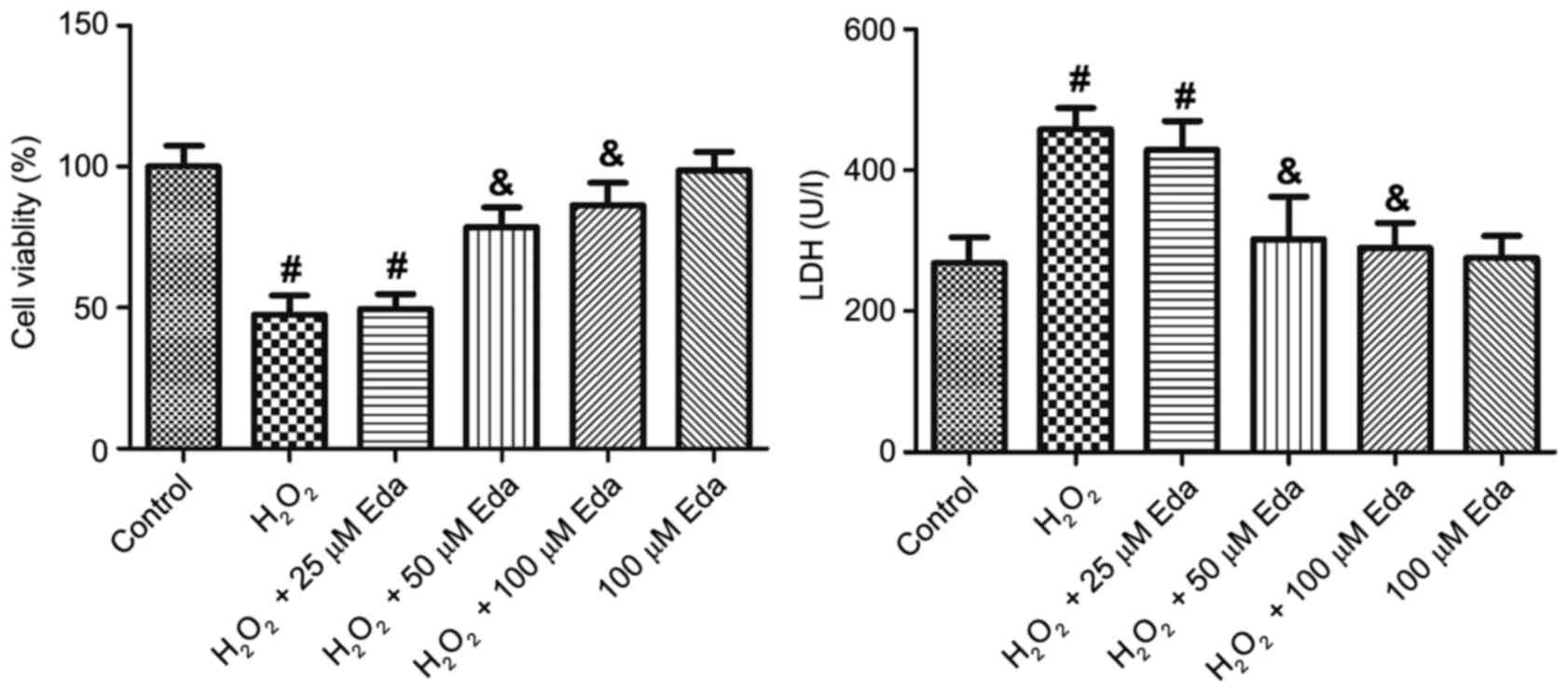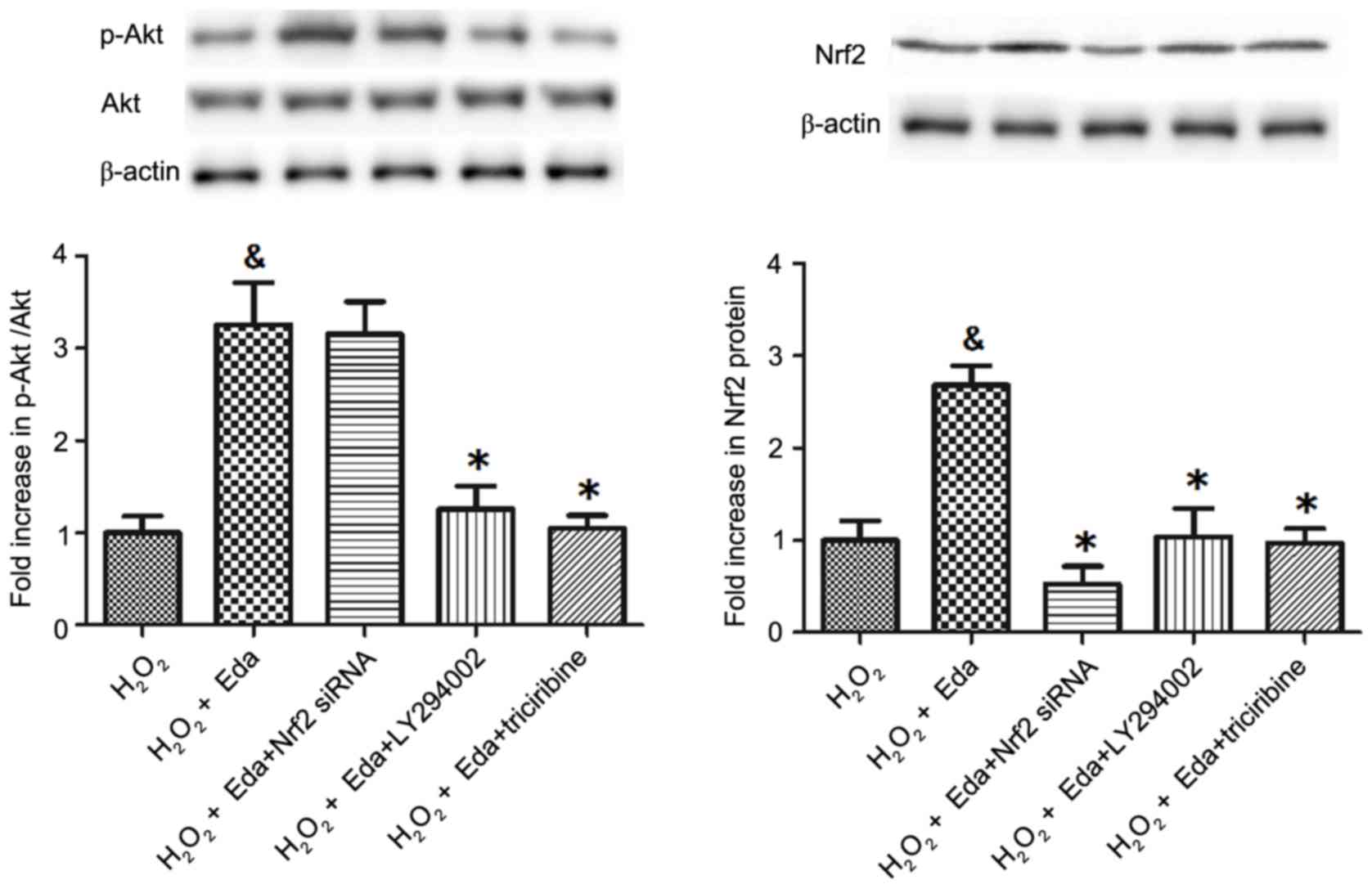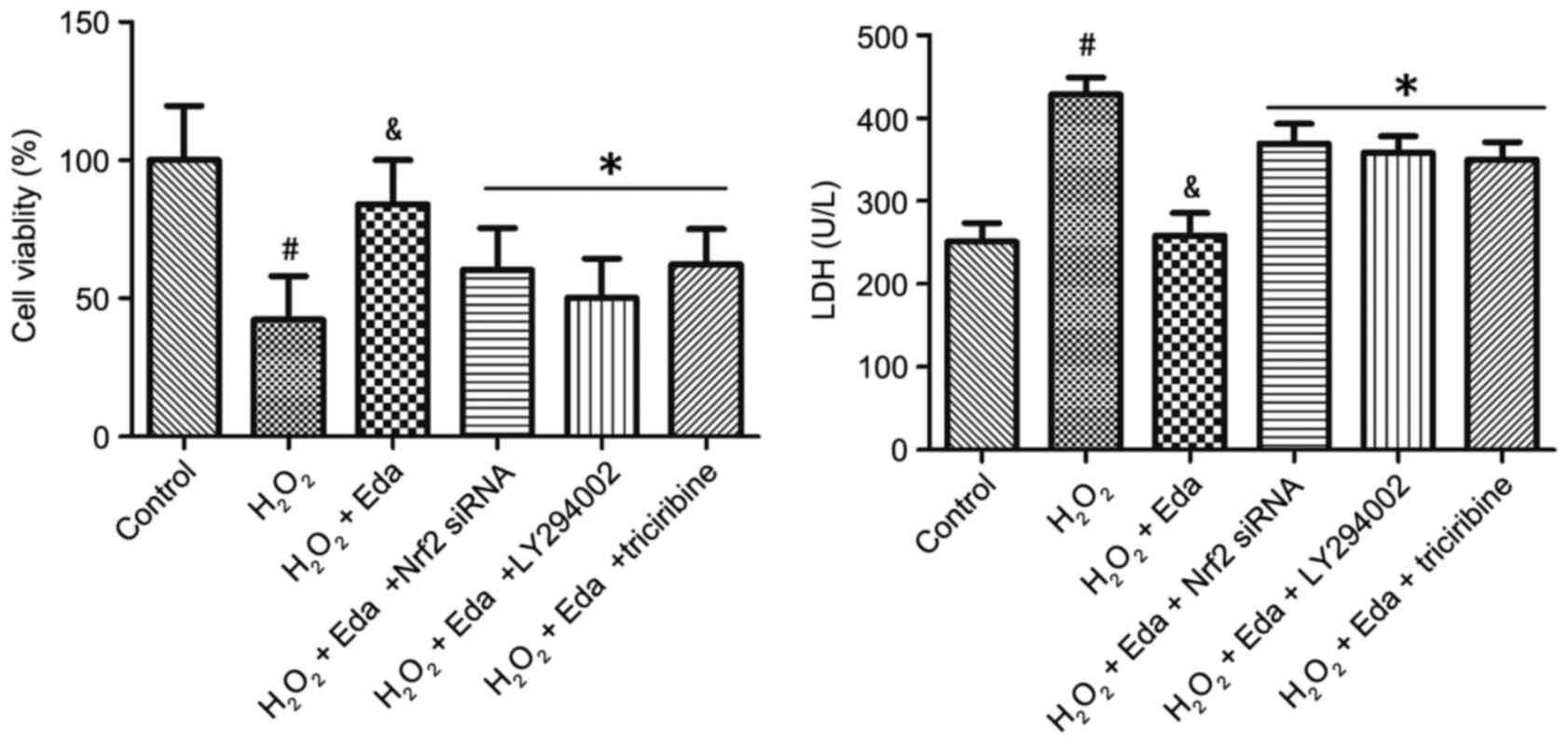|
1
|
Kaur C, Foulds WS and Ling EA:
Blood-retinal barrier in hypoxic ischaemic conditions: Basic
concepts, clinical features and management. Prog Retin Eye Res.
27:622–647. 2008. View Article : Google Scholar : PubMed/NCBI
|
|
2
|
Archer DB: Tributary vein obstruction:
Pathogenesis and treatment of sequelae. Doc Ophthalmol. 40:339–360.
1976. View Article : Google Scholar : PubMed/NCBI
|
|
3
|
Hayreh SS: Ischemic optic neuropathy. Int
Ophthalmol. 1:9–18. 1978. View Article : Google Scholar : PubMed/NCBI
|
|
4
|
Verma D: Pathogenesis of diabetic
retinopathy-the missing link? Med Hypotheses. 41:205–210. 1993.
View Article : Google Scholar : PubMed/NCBI
|
|
5
|
Nickells RW: Retinal ganglion cell death
in glaucoma: The how, the why, and the maybe. J Glaucoma.
5:345–356. 1996. View Article : Google Scholar : PubMed/NCBI
|
|
6
|
Hayreh SS, Zimmerman MB, Kimura A and
Sanon A: Central retinal artery occlusion. Retinal survival time.
Exp Eye Res. 78:723–736. 2004. View Article : Google Scholar : PubMed/NCBI
|
|
7
|
Mukaida Y, Machida S, Masuda T and Tazawa
Y: Correlation of retinal function with retinal histopathology
following ischemia-reperfusion in rat eyes. Curr Eye Res.
28:381–389. 2004. View Article : Google Scholar : PubMed/NCBI
|
|
8
|
Aydemir O, Celebi S, Yilmaz T, Yekeler H
and Kükner AS: Protective effects of vitamin E forms
(alpha-tocopherol, gamma-tocopherol and d-alpha-tocopherol
polyethylene glycol 1000 succinate) on retinal edema during
ischemia-reperfusion injury in the guinea pig retina. Int
Ophthalmol. 25:283–289. 2004. View Article : Google Scholar : PubMed/NCBI
|
|
9
|
Pace PW, Yao LJ, Wilson JX, Possmayer F,
Veldhuizen RA and Lewis JF: The effects of hyperoxia exposure on
lung function and pulmonary surfactant in a rat model of acute lung
injury. Exp Lung Res. 35:380–398. 2009. View Article : Google Scholar : PubMed/NCBI
|
|
10
|
Reddy NM, Kleeberger SR, Kensler TW,
Yamamoto M, Hassoun PM and Reddy SP: Disruption of Nrf2 impairs the
resolution of hyperoxia-induced acute lung injury and inflammation
in mice. J Immunol. 182:7264–7271. 2009. View Article : Google Scholar : PubMed/NCBI
|
|
11
|
Watanabe T, Tanaka M, Watanabe K,
Takamatsu Y and Tobe A: Research and development of the free
radical scavenger edaravone as a neuroprotectant. Yakugaku Zasshi.
124:99–111. 2004. View Article : Google Scholar : PubMed/NCBI
|
|
12
|
Kaur C and Ling EA: Antioxidants and
neuroprotection in the adult and developing central nervous system.
Curr Med Chem. 15:3068–3080. 2008. View Article : Google Scholar : PubMed/NCBI
|
|
13
|
Yoshida H, Yanai H, Namiki Y,
Fukatsu-Sasaki K, Furutani N and Tada N: Neuroprotective effects of
edaravone: A novel free radical scavenger in cerebrovascular
injury. CNS Drug Rev. 12:9–20. 2006. View Article : Google Scholar : PubMed/NCBI
|
|
14
|
Liu S, Li R, Ni X, Cai Z, Zhang R, Sun X,
Quock RM and Xu W: Perfluorocarbon-facilitated CNS oxygen toxicity
in rats: Reversal by edaravone. Brain Res. 1471:56–65. 2012.
View Article : Google Scholar : PubMed/NCBI
|
|
15
|
Song Y, Gong YY, Xie ZG, Li CH, Gu Q and
Wu XW: Edaravone (MCI-186), a free radical scavenger, attenuates
retinal ischemia/reperfusion injury in rats. Acta Pharmacol Sin.
29:823–828. 2008. View Article : Google Scholar : PubMed/NCBI
|
|
16
|
Institute of Laboratory Animal Resources,
Commission on Life Sciences, National Research Council, . Guide for
the Care and Use of Laboratory Animals. National Academy Press;
Washington, DC: 1996
|
|
17
|
Tong N, Zhang Z, Gong Y, Yin L and Wu X:
Diosmin protects rat retina from ischemia/reperfusion injury. J
Ocul Pharmacol Ther. 28:459–466. 2012. View Article : Google Scholar : PubMed/NCBI
|
|
18
|
Ohkawa H, Ohishi W and Yagi K:
Determination of lipid peroxidation by MDA. Anal Biochem.
95:351–358. 1979. View Article : Google Scholar : PubMed/NCBI
|
|
19
|
Pathak R, Suke SG, Ahmed T, Ahmed RS,
Tripathi AK, Guleria K, Sharma CS, Makhijani SD and Banerjee BD:
Organochlorine pesticide residue levels and oxidative stress in
preterm delivery cases. Hum Exp Toxicol. 29:351–358. 2010.
View Article : Google Scholar : PubMed/NCBI
|
|
20
|
Bai L, Pang WJ, Yang YJ and Yang GS:
Modulation of Sirt1 by resveratrol and nicotinamide alters
proliferation and differentiation of pig preadipocytes. Mol Cell
Biochem. 307:129–140. 2008. View Article : Google Scholar : PubMed/NCBI
|
|
21
|
Chang Y, Yang ST, Liu JH, Dong E, Wang Y,
Cao A, Liu Y and Wang H: In vitro toxicity evaluation of graphene
oxide on A549 cells. Toxicol Lett. 200:201–210. 2011. View Article : Google Scholar : PubMed/NCBI
|
|
22
|
Osborne NN, Casson RJ, Wood JP, Chidlow G,
Graham M and Melena J: Retinal ischemia: Mechanisms of damage and
potential therapeutic strategies. Prog Retin Eye Res. 23:91–147.
2004. View Article : Google Scholar : PubMed/NCBI
|
|
23
|
Zheng L, Gong B, Hatala DA and Kern TS:
Retinal ischemia and reperfusion causes capillary degeneration:
Similarities to diabetes. Invest Ophthalmol Vis Sci. 48:361–367.
2007. View Article : Google Scholar : PubMed/NCBI
|
|
24
|
Fernandez DC, Bordone MP, Chianelli MS and
Rosenstein RE: Retinal neuroprotection against ischemia-reperfusion
damage induced by postconditioning. Invest Ophthalmol Vis Sci.
50:3922–3930. 2009. View Article : Google Scholar : PubMed/NCBI
|
|
25
|
Li C, Wang L, Huang K and Zheng L:
Endoplasmic reticulum stress in retinal vascular degeneration:
Protective role of resveratrol. Invest Ophthalmol Vis Sci.
53:3241–3249. 2012. View Article : Google Scholar : PubMed/NCBI
|
|
26
|
Maher P and Hanneken A: Flavonoids protect
retinal ganglion cells from oxidative stress-induced death. Invest
Ophthalmol Vis Sci. 46:4796–4803. 2005. View Article : Google Scholar : PubMed/NCBI
|
|
27
|
Peters O, Back T, Lindauer U, Busch C,
Megow D, Dreier J and Dirnagl U: Increased formation of reactive
oxygen species after permanent and reversible middle cerebral
artery occlusion in the rat. J Cereb Blood Flow Metab. 18:196–205.
1998. View Article : Google Scholar : PubMed/NCBI
|
|
28
|
Kevin LG, Camara AK, Riess ML, Novalija E
and Stowe DF: Ischemic preconditioning alters real-time measure of
O2 radicals in intact hearts with ischemia and reperfusion. Am J
Physiol Heart Circ Physiol. 284:H566–H574. 2003. View Article : Google Scholar : PubMed/NCBI
|
|
29
|
Chen YQ, Pan WH, Liu JH, Chen MM, Liu CM,
Yeh MY, Tsai SK, Young MS, Zhang XM and Chao HM: The effects and
underlying mechanisms of S-allyl l-cysteine treatment of the retina
after ischemia/reperfusion. J Ocul Pharmacol Ther. 28:110–117.
2012. View Article : Google Scholar : PubMed/NCBI
|
|
30
|
Valko M, Leibfritz D, Moncol J, Cronin MT,
Mazur M and Telser J: Free radicals and antioxidants in normal
physiological functions and human disease. Int J Biochem Cell Biol.
39:44–84. 2007. View Article : Google Scholar : PubMed/NCBI
|
|
31
|
Parinandi NL, Kleinberg MA, Usatyuk PV,
Cummings RJ, Pennathur A, Cardounel AJ, Zweier JL, Garcia JG and
Natarajan V: Hyperoxia-induced NAD(P)H oxidase activation and
regulation by MAP kinases in human lung endothelial cells. Am J
Physiol Lung Cell Mol Physiol. 284:L26–L38. 2003. View Article : Google Scholar : PubMed/NCBI
|
|
32
|
Schwartz M: Neuroprotection as a treatment
for glaucoma: Pharmacological and immunological approaches. Eur J
Ophthalmol. 13 Suppl 3:S27–S31. 2003.PubMed/NCBI
|
|
33
|
Clutton S: The importance of oxidative
stress in apoptosis. Br Med Bull. 53:662–668. 1997. View Article : Google Scholar : PubMed/NCBI
|
|
34
|
Meldrum DR, Dinarello CA, Cleveland JC Jr,
Cain BS, Shames BD, Meng X and Harken AH: Hydrogen peroxide induces
tumor necrosis factor alpha-mediated cardiac injury by a P38
mitogen-activated protein kinase-dependent mechanism. Surgery.
124:291–297. 1998. View Article : Google Scholar : PubMed/NCBI
|
|
35
|
Toker A and Cantley LC: Signalling through
the lipid products of phosphoinositide-3-OH kinase. Nature.
387:673–676. 1997. View
Article : Google Scholar : PubMed/NCBI
|
|
36
|
Ryu MJ, Kang KA, Piao MJ, Kim KC, Zheng J,
Yao CW, Cha JW, Chung HS, Kim SC, Jung E, et al:
7,8-Dihydroxyflavone protects human keratinocytes against oxidative
stress-induced cell damage via the ERK and PI3K/Akt-mediated
Nrf2/HO-1 signaling pathways. Int J Mol Med. 33:964–970. 2014.
View Article : Google Scholar : PubMed/NCBI
|
|
37
|
Hua K, Sheng X, Li TT, Wang LN, Zhang YH,
Huang ZJ and Ji H: The edaravone and 3-n-butylphthalide
ring-opening derivative 10b effectively attenuates cerebral
ischemia injury in rats. Acta Pharmacol Sin. 36:917–927. 2015.
View Article : Google Scholar : PubMed/NCBI
|
|
38
|
Kang KW, Lee SJ and Kim SG: Molecular
mechanism of nrf2 activation by oxidative stress. Antioxid Redox
Signal. 7:1664–1673. 2005. View Article : Google Scholar : PubMed/NCBI
|













